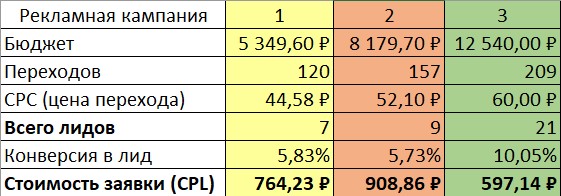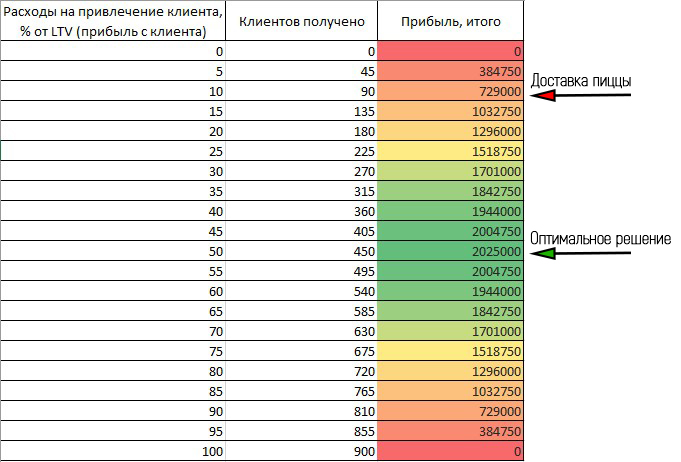Hello! I want to introduce you to how in a marketing company we calculate the effectiveness of advertising.
What is the difference between the effectiveness and efficiency of advertising?
Suppose your manager managed to attract 400 customers who made a purchase, but he spent on it such an amount of the advertising budget that does not pay for the attracted customers. This alignment is effective, but you cannot call it effective. Productivity is nothing without the effectiveness of an advertising campaign. Now let's figure out what efficiency is and how to calculate it correctly.
Understanding the effectiveness of advertising gives knowledge about where to invest your advertising budget in order to get maximum profit.
How to evaluate the effectiveness of advertising
The first thing to do is to focus on profit, and for this you need to keep up-to-date data on the following indicators:
- Customer value
- Application cost
- Sales conversion
Customer Cost (LTV)
By customer value we mean the customer’s lifetime value (LTV - Life time value). This indicator allows you to calculate profit from the client for the entire period of his cooperation with the company, thus showing the true profit from the client. Knowing your LTV opens up new possibilities for attracting a flow of customers. For example, you consider only the first sale and are ready to spend 300 rubles to attract a client; and a completely different case, you consider LTV and are ready to pay 9,000 rubles for a client. It is clear that these are completely different prospects in terms of attracting new customers. Let's analyze the calculation of customer value (LTV) on the example of pizza delivery.
LTV = profit from one sale * number of purchases per year * customer lifetime in years.
For example, you have:
- Average check = 700 rubles.
- Operating expenses (for the manufacture of pizza, its delivery and salaries to employees, taxes, etc.) = 400 rubles.
- On average, a client makes 10 orders a year.
- On average, a client “lives” for 3 years.
- Then your LTV = (700 - 400) * 10 * 3 = 9000 rubles.
Customer Cost (LTV) must be understood in order to correctly calculate how much money can be invested to attract each new customer.
Application Price (CPL)
The simplest metric is CPL (Cost per Lead or Cost of Lead Acquisition). Google collected statistics from all Google Analytics accounts and found that only half of all users use goal setting. Therefore, if you still do not know the value of your application, you lose a big advantage in the development of your business.
In order to calculate CPL, simple calculations in the excel file and data on the number of clicks, the cost of one transition and the number of conversions will be enough.

As you can see from the table, not always the lowest average conversion price means the lowest bid cost (CPL).
Sales conversion
In order to calculate the conversion of an application for sale, you can use the simple formula:
Conversion (%) = Number of real customers / number of applications.For example, there is a company with which you receive 50 applications from the site, but only 20 of them turn into real customers. By simple calculations, we get a conversion of 40%.
Putting it all together
After all the data is collected, it is necessary to calculate the percentage of profit that is most profitable to invest in advertising. In order to make it easier for you, we will analyze everything with a detailed example with calculations.
Let's say we are the same pizza delivery company. LTV, as we found out, is 9,000 rubles. This is the profit that the client brings to us for the entire period of cooperation with our company.
We also have a website and a customized advertising campaign in Yandex.Direct, through which 2,000 visitors a month come to us. The average transition price is 50 rubles, that is, the advertising budget for the month is 100 000 rubles. With this advertising campaign in a month you receive 200 applications, so the conversion of a visitor to a lead is 10%. The application cost indicator (CPL) is 500 rubles (100,000 rubles / 200 applications) - this is the amount that costs us 1 application, but part of the applications “flies” for various reasons and from 200 applications you receive 100 orders. Accordingly, attracting a new client costs you 1000 rubles.
Agree that the cost of attracting a client (1000 rubles) relative to all profits from him (9000 rubles) is quite small, it follows that more active use of the advertising campaign is possible due to, for example, raising rates. However, to what level can they be raised? The answer to this question lies in the particularity of the algorithm for determining the price of the transition in advertising (contextual, targeted, banner). The more clicks we want, the more expensive they cost us.
Ad Cost Guidelines
The more traffic to the site you want to receive from an advertising source, the higher you need to raise your bids, unless of course there are no more phrases / audiences for which you are not promoting. You need to understand to what level you can raise bets.
We recommend that you adhere to the rule (it’s conditional): “Advertising costs - no more than 50% of client’s profit (LTV)."
If after calculations it turned out that advertising costs are less than half of your income, then you should test the increase in the advertising budget. For clarity, consider the same example with pizza delivery in the form of a table that shows the dependence of the percentage of advertising costs on client profit (LTV) and the total profit received:

In this example, the share of expenses on attracting a client is ~ 11% of LTV and in this case the client will receive (since LTV also implies deferred profit) 800 thousand rubles, because (9000 - 1000) * 100 = 800000. The table shows that, by increasing the activity of advertising due to higher rates, you can come to a more optimal solution.